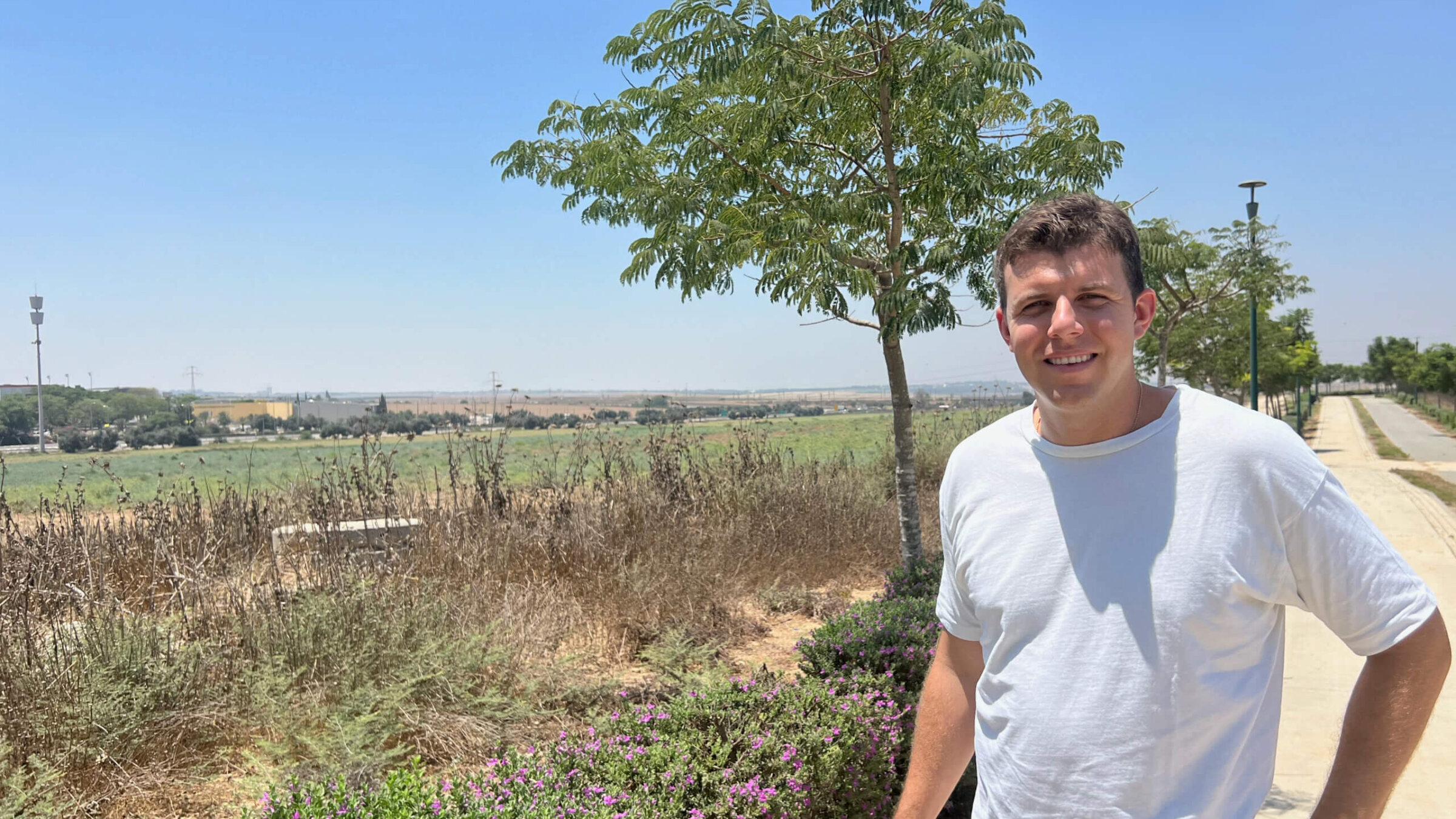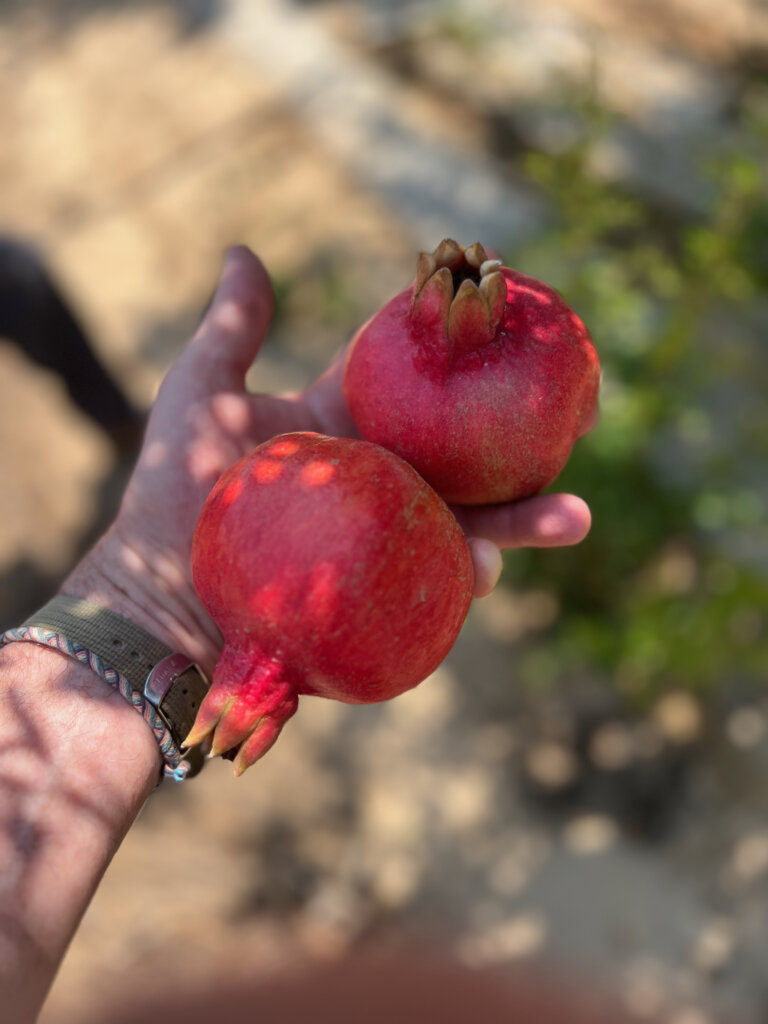A year after Oct. 7, Israel’s south is still discovering new depths of resilience
Revitalization efforts in the war-torn region include plans for a new public university — and a distiller producing Israel’s first tequila

Amit Kochavi overlooks the future site of a new Sapir College campus in Sderot, Israel. Photo by Rob Eshman
Hamas terrorists massacred close to 30 police officers and civilians inside the police station in Sderot, the southern city bordering the Gaza Strip, on Oct. 7. For months afterward, the city lay almost empty, most of its 35,000 residents evacuated.
“You can’t even imagine how it was — a ghost town, no cars, nothing,” said Amit Kochavi, a 26-year-old tech entrepreneur now overseeing part of the revitalization efforts in the city.
Kochavi and I stood on a hill overlooking both Gaza and Sderot, where a coin-operated telescope was mounted. Looking west, I could see the town of Beit Hanoun in Gaza lying in ruins, with apartment buildings crumbled on their sides, the streets empty after Israel’s assault on Gaza in response to the Oct. 7 attack
Kochavi, swinging the telescope west, pointed out a new neighborhood in development, part of a plan to build 6,000 additional housing units in the next five years. Kochavi then pointed farther south to an empty field where construction on a massive new public university will soon be underway. After, as we drove by the empty lot where the bulldozed police headquarters once stood, Kochavi said a state-of-the-art station will be constructed there, not far from a new rehabilitation and trauma treatment center.
Kochavi, who is younger than most American business school grads, is overseeing $300 million of redevelopment out of the region’s $5 billion commitment. Just as striking is that no one asked him to do this work — he volunteered to be involved with the effort.
Even more remarkable is that on a recent reporting trip to Israel, I met so many people like Kochavi, digging in to rebuild and even reimagine their country’s future after the devastations of Oct. 7.
A plan to take Sderot ‘five steps forward’
Kochavi, who is tall, serious and movie-star handsome, does not have the standard 25-year-old resume. Before taking on leadership for the Sderot revitalization effort, he served in an elite Air Force unit, created and sold one tech company and started another.
A day after the Hamas attack, Kochavi left his apartment in Tel Aviv, picked up a friend, gathered some supplies — food, clothing, medicines — and drove down to Sderot to help out.
For the next two weeks, he left Tel Aviv every day at noon, his small car stuffed with supplies, not returning home until 3 a.m.
“It was crazy,” said Kochavi. “I decided we needed to think more strategically.”
So he arranged a meeting with Sderot’s mayor, Alon Davidi, to figure out how they could get philanthropic funding to help the municipality create a temporary educational system for its displaced children. He put together an advisory board of academic leaders to develop an overall plan to help the town get back on its feet.
“I told him that we will build a plan for the city to not only come back to what it was,” said Kochavi, “but five steps forward.”
From those first plans, Kochavi’s vision for Sderot morphed to include a half-dozen regional development projects — including renovating old buildings into student housing; developing a branch of the Rimon Academy, Israel’s most prestigious music school; and establishing a 3-D printing laboratory to develop prosthetic limbs.
The anchor of the plan is the expansion of Sapir College, Israel’s largest public college, which currently instructs some 8,000 students in the Negev. The university’s new outpost near Sderot will host 3,000 students, and buildings for studies in artificial intelligence, computer science and agricultural science, along with an applied research and development center for water technology and clean energy.
“You want to develop a region bottom up, not top down,” said Kochavi. Better educational opportunities will bring more entrepreneurs, more people — he hopes to eventually double Sderot’s population — and more investment.
His insights have a pedigree. Kochavi’s father, Doron, helped develop numerous Tel Aviv neighborhoods. His paternal grandparents were pioneer industrialists and philanthropists in the city.
Kochavi, who sits on the board of his family’s Buchman-Heyman Foundation, spearheaded multi-million philanthropic donations from the Jewish Federations of Toronto and Los Angeles, as well as private foundations.
He did all this as a volunteer, until he decided to pull back from running his Tel Aviv start-up and take a full-time position as an senior advisor to Sderot’s mayor. He still lives in Tel Aviv, but makes the commute at least three times each week.
“I made the decision that I’m not going to leave this area in the next couple of years,” he said, “until this is built.”
A ‘happy place’ for refugees of terror
Kochavi isn’t alone in believing that the only way for Israel’s south to recover is to completely re-envision its future.

A day after meeting Kochavi, I traveled 20 minutes from Sderot to Kibbutz Mishmar HaNegev, which is planting 65 acres with a new variety of pomegranate, the Neta, that Israeli scientists developed to ripen in July, at least a month before the usual variety. The trim rows of new trees — all irrigated with recycled water from the nearby Bedouin town of Rahat — are as clear a metaphor as any for Israelis’ determination to rebuild and renew.
Just north of the kibbutz, a group of American-born entrepreneurs are heading up an even longer term project: planting agave in order to eventually produce Israel’s first tequila-like distillate. Their initial planting has filled 26 acres with the spiny succulent.
The first shots of the high-end product, called Negave, will flow from the desert-friendly plants in four years, according to co-founder David Niewood.
“Either the area is over,” he said, “or we bring it back better.”
Back in Sderot, Kochavi took me to a start-up incubator that has launched 30 companies, providing 250 jobs in the region. Kochavi and Davidi, Sderot’s mayor, are raising private capital to expand the incubator to work with at least 150 companies.
“Maybe it would have happened before Oct. 7,” Kochavi said, of Sderot’s development. “But the idea behind bringing it 10 steps forward is to show the other side that they infiltrated, and we’re building here something stronger, and better.”
















